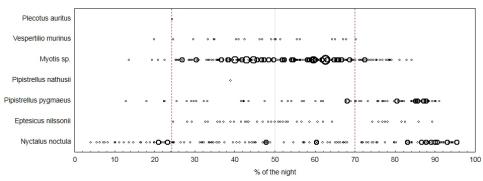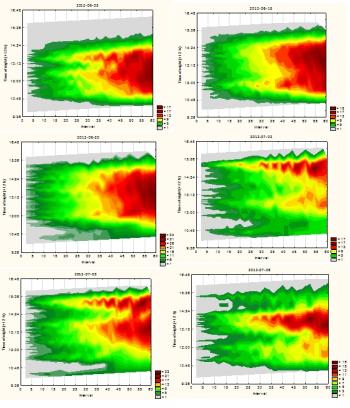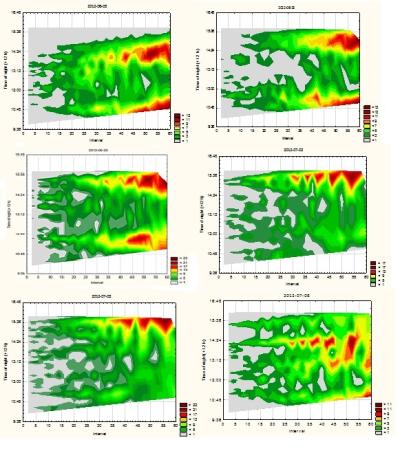Results
Occurrence pattern

The nightly occurrence pattern showed interesting differences among the recorded species.
Three species had a long period of activity, N. noctula beeing the one with longest activity period (from 4% to 95%). Also some species starts late and some end early, E. nilssonii being a late starter (25% into the night) and V. murinus being the one that finished first (70% into the night). Furthermore no species suggest a drop, or pause, in inactivity during the night.
Note that there had only been one observation of P. nathusii and P. auritus.
Observation distribution

Three nights had an increase of observations from sunset and then the number of observations remained constant until shortly before sunrise. Two other nights displayed a simmular pattern while the last night had a small interval of great observations in the middle of the night.
Figure: The distribution of observations of the five most frequent species per night. y-axis is "Time of night (+ 12 h)", x-axis is "Interval" and spans from 2 - 60 min.
Change in observations

The result of Webster’s method showing the change in number of observations from one time interval to the next, highlighting substantial changes in the beginning and the end of three night. Two other nights one can see a major change in the end of the nights while one night have change around 14:24.
Figure: Change in observations for the five most frequent species per night. y-axis is "Time of night (+ 12 h)", x-axis is "Interval" and spans from 2 - 60 min.
Weather factors

There were two factors that affected all four dependent parameters the same: temperature (with negative effect) and air pressure (positive effect).
The number of species and sum of observations seem to be affected by the independent factors in a similar way, except for two parameters, cloud and moonlight. N. noctula and M. daubentonii is only affected similar by three factors, temp, cloud and air pressure, otherwise they have an opposite response towards another.
Table: r values from linear regression. * represents P values below 0.05 while (*) represent P values above 0.05 but below 0.10.
Responsible for this page:
Director of undergraduate studies Biology
Last updated:
05/16/13
